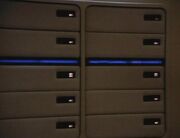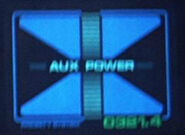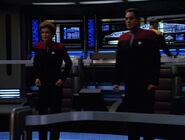m (Nav template) |
No edit summary |
||
| (11 intermediate revisions by 7 users not shown) | |||
| Line 6: | Line 6: | ||
The alert for starships on [[auxiliary power]] in [[2287]] was a blue status screen, along with the main lighting on the [[bridge]] switching to blue. ({{film|5}}) |
The alert for starships on [[auxiliary power]] in [[2287]] was a blue status screen, along with the main lighting on the [[bridge]] switching to blue. ({{film|5}}) |
||
| − | In [[2367]], the event of an imminent environmental systems failure or disruption resulted in blue alert being called in the |
+ | In [[2367]], the event of an imminent environmental systems failure or disruption resulted in blue alert being called in the affected areas in order to help affected personnel escape or safeguard their lives. ({{TNG|Brothers}}) |
| + | |||
| + | {{bginfo|The blue lighting effect seen in "Brothers" was created in post production by altering the hue of the standard "red alert". In the remastered version of the episode, the lighting remains red. {{eas|observations/tng-r-changes.htm#4}}}} |
||
The {{USS|Defiant|2370}} went to blue alert when engaging its [[Romulan]] [[cloaking device]] in [[2371]]. ({{DS9|The Search, Part I}}) |
The {{USS|Defiant|2370}} went to blue alert when engaging its [[Romulan]] [[cloaking device]] in [[2371]]. ({{DS9|The Search, Part I}}) |
||
| − | On a vessel with landing capabilities, such as the {{ |
+ | On a vessel with landing capabilities, such as the {{Class|Intrepid}}, blue alert was called as an indication that the ship was preparing either to land or to take off; the crew would then need to report to code blue stations, in order to aid in the landing/liftoff procedures. ({{VOY|The 37's|Demon}}) Blue alert was the minimum required ship status for landing an ''Intrepid''-class starship, as the {{USS|Voyager}} did make a landing while at [[red alert]] without switching to blue alert status. ({{VOY|Dragon's Teeth}}) Exceptions are known, in {{VOY|Tattoo}} a landing was initiated without calling any alert first. Only when already in the atmosphere and the landing was not going according to plan a red alert was called. |
| − | Blue alert was also used when a {{ |
+ | Blue alert was also used when a {{Class|Prometheus}} starship activated its [[multi-vector assault mode]]. ({{VOY|Message in a Bottle}}) |
| − | {{bginfo|This could also indicate that blue alert would be called on {{ |
+ | {{bginfo|This could also indicate that blue alert would be called on {{Class|Galaxy}} ships prior to [[saucer separation]], although this protocol was never referenced in any of the instances of that occurring on ''[[Star Trek: The Next Generation|The Next Generation]]''.}} |
<gallery> |
<gallery> |
||
| Line 22: | Line 24: | ||
</gallery> |
</gallery> |
||
| − | {{ |
+ | {{alert signals}} |
[[de:Blauer Alarm]] |
[[de:Blauer Alarm]] |
||
Revision as of 17:12, 25 April 2014

Blue alert aboard the USS Enterprise-D
Blue alert (also code blue or condition blue) was an alert signal status on Starfleet vessels and outposts which was called for in exceptional situations, including, but not limited to, environmental hazards to the crew, main power failure, docking and separation maneuvers, and landing protocols, for ships with the capability.
The bridge lighting on the refitted USS Enterprise turned blue when it prepared to enter the Earth Spacedock in 2285. (Star Trek III: The Search for Spock)
The alert for starships on auxiliary power in 2287 was a blue status screen, along with the main lighting on the bridge switching to blue. (Star Trek V: The Final Frontier)
In 2367, the event of an imminent environmental systems failure or disruption resulted in blue alert being called in the affected areas in order to help affected personnel escape or safeguard their lives. (TNG: "Brothers")
The USS Defiant went to blue alert when engaging its Romulan cloaking device in 2371. (DS9: "The Search, Part I")
On a vessel with landing capabilities, such as the Intrepid-class, blue alert was called as an indication that the ship was preparing either to land or to take off; the crew would then need to report to code blue stations, in order to aid in the landing/liftoff procedures. (VOY: "The 37's", "Demon") Blue alert was the minimum required ship status for landing an Intrepid-class starship, as the USS Voyager did make a landing while at red alert without switching to blue alert status. (VOY: "Dragon's Teeth") Exceptions are known, in VOY: "Tattoo" a landing was initiated without calling any alert first. Only when already in the atmosphere and the landing was not going according to plan a red alert was called.
Blue alert was also used when a Prometheus-class starship activated its multi-vector assault mode. (VOY: "Message in a Bottle")
| Alert signals | |
|---|---|
| Colored alerts: | Red • Double Red • Yellow • Blue • Gray • Black • Green |
| General alerts: | Battle stations • "Brace for impact" • Emergency stations • General quarters |
| Battle • Evacuation • Fire • Intruder • Perimeter • Proximity • Security • Standby • Tactical • Visitor | |



